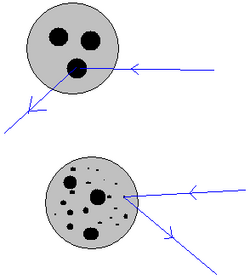Physics:Parton Distribution Functions
In particle physics, Parton Distribution Functions (or PDF) are the probabilities to find partons (quarks and gluons) in a hadron
as a function of the fraction of the proton's momentum carried by the parton. They are conventionally defined in terms of matrix elements of certain operators. They are determined from experimental results on short distance scattering of the partons.
The term was introduced by Richard Feynman [1] (1969) in the parton model, to explain Bjorken scaling in deep inelastic scattering data; interpretation as probability distributions according to the QCD factorisation theorem for inclusive hard scattering processes, universal distributions containing long-distance structure of hadrons; related to parton model distributions at leading order, but with logarithmic scaling violations (DGLAP). A hadron is composed of a number of point-like constituents, termed "partons". Later, with the experimental observation of Bjorken scaling, the validation of the quark model, and the confirmation of asymptotic freedom in quantum chromodynamics, partons were matched to quarks and gluons.
Partons are defined with respect to a physical scale (as probed by the inverse of the momentum transfer). For instance, a quark parton at one length scale can turn out to be a superposition of a quark parton state with a quark parton and a gluon parton state together with other states with more partons at a smaller length scale. Similarly, a gluon parton at one scale can resolve into a superposition of a gluon parton state, a gluon parton and quark-antiquark partons state and other multiparton states. Because of this, the number of partons in a hadron actually goes up with momentum transfer.[2] At low energies (i.e. large length scales), a baryon contains three valence partons (quarks) and a meson contains two valence partons (a quark and an antiquark parton). At higher energies, however, observations show sea partons (nonvalence partons) in addition to valence partons.[3]
Mathematically, the probability of a parton of type [math]\displaystyle{ i }[/math] having a fraction [math]\displaystyle{ x }[/math] of the proton energy is the parton distribution function (pdf ) [math]\displaystyle{ f_i(x) }[/math]. The gluon PDF steeply rises with a decrease of [math]\displaystyle{ x }[/math] as it was established by the HERA experiments.
References
- ↑ Feynman, R. P. (1969). "The Behavior of Hadron Collisions at Extreme Energies". Gordon & Breach. pp. 237–249. ISBN 978-0-677-13950-0.
- ↑ G. Altarelli and G. Parisi (1977). "Asymptotic Freedom in Parton Language". Nuclear Physics B126 (2): 298–318. doi:10.1016/0550-3213(77)90384-4. Bibcode: 1977NuPhB.126..298A.
- ↑
Drell, S.D.; Yan, T.-M. (1970). "Massive Lepton-Pair Production in Hadron-Hadron Collisions at High Energies". Physical Review Letters 25 (5): 316–320. doi:10.1103/PhysRevLett.25.316. Bibcode: 1970PhRvL..25..316D.
- And erratum in Drell, S. D.; Yan, T.-M. (1970). "none". Physical Review Letters 25 (13): 902. doi:10.1103/PhysRevLett.25.902.2. Bibcode: 1970PhRvL..25..902D.
 |


